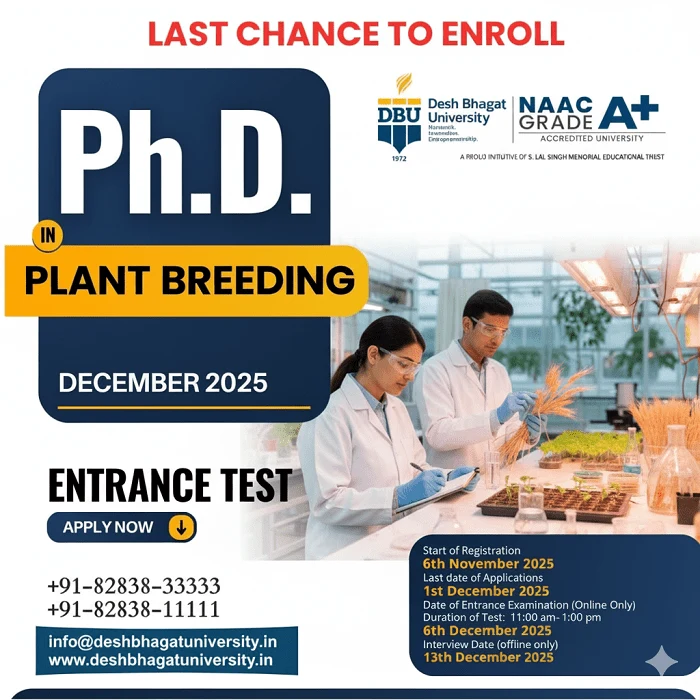PhD in Plant Breeding: Course, Objectives, and Techniques
November 7, 2025 2025-11-07 11:58PhD in Plant Breeding: Course, Objectives, and Techniques

PhD in Plant Breeding: Course, Objectives, and Techniques
What is Plant Breeding
Plant breeding is the science and art of improving plants so that they give better yields, resist diseases, and adapt to environments. In simple words, plant breeders select plants that have good qualities and then cross them or modify them so future crops are better. At Desh Bhagat University (DBU), the agriculture programs include “Principles of Plant Breeding” in their curriculum, highlighting the importance of improving plant varieties for better yield and quality.
In plant breeding, you consider traits like larger fruits, stronger stems, tolerance to drought or pests, better quality seeds, and so on. It links genetics, biotechnology, and field work. For example, DBU’s “Plant Breeding & Genetics Lab” provides practical access to these concepts.
When you move to a postgraduate or doctoral level—say a PhD in plant breeding—you focus on deeper research: new varieties, advanced genetics, molecular tools, gene manipulation, etc. That makes your role very important in agriculture, horticulture, and allied crop sciences.
What is a PhD in Plant Breeding
A PhD in Plant Breeding is a research-based program where you study how to improve plants. This includes making them grow better, resist diseases, and adapt to different environments. During the program, you will conduct experiments, learn about genetics and biotechnology, and contribute new knowledge to help improve crops.
In such a PhD, you typically:
- Choose a specific research topic in plant breeding (for example, improving a crop, hybridization, male sterility, genetic breeding)
- Do coursework, research methodology, and then extensive field/lab work
- Publish research findings, write a thesis/dissertation
- Defend your research and contribute new knowledge in plant breeding.
Plant Breeding PhD Programmes: What to Expect at DBU
Here’s what one can expect if you pursue a plant breeding–related PhD at DBU. These are realistic features based on the agriculture/horticulture faculty offerings.
Eligibility:
- A relevant Master’s degree (for example, in agriculture, horticulture, botany, genetics) with required marks.
- For reserved categories, some relaxation may apply (DBU’s general PhD criteria indicate this for other programmes).
- Research proposal and interview as part of the admission.
- The research infrastructure exists: DBU lists plant breeding & genetics lab, agronomy & soil science lab, etc.
Duration & Structure:
- Minimum 3 years and up to 6 years for completion (as seen for doctoral programmes at DBU)
- Initial coursework to build research skills, then research phase where you carry out experiments, lab/field work, and data analysis.
- Final thesis writing and defence.
Research Topics & Focus Areas:
In plant breeding PhD programmes, you might work on:
- Developing new varieties of crops with improved yield or quality
- Hybridization techniques to combine good traits from two parent plants
- Male sterility in crops to help produce hybrids efficiently
- Genetic plant breeding (using genetics, gene editing, and biotechnology)
- Investigating plant breeding techniques (classical and modern)
- Applying breeding in horticulture, field crops, vegetables, and fruits.
Facilities & Labs:
DBU specifically mentions “Plant Breeding & Genetics Lab” under its laboratory infrastructure. Also, the curriculum of BSc and MSc mentions courses in plant breeding and genetics.
Objectives of Plant Breeding
When you engage in plant breeding (and especially at PhD level) you keep clear objectives in mind. Some key objectives include:
- Improving crop yield and quality
Plant breeding aims to develop varieties that yield more, have better nutritional value, better marketability, and cost‐efficient production. - Enhancing resistance to pests, diseases, and stresses
One objective is to breed plants that resist diseases, pests, drought, salinity, and heat—so that crops succeed under difficult conditions. - Adaptation to the environment and resource‐use efficiency
Plants may be bred to use water more efficiently, tolerate poor soils or extreme climate, thereby helping sustainable agriculture. - Developing hybrids and new varieties
Hybridization is a method used to combine desirable traits. The objective is to harness heterosis (hybrid vigor) for better performance. - Genetic improvement and diversity conservation
Plant breeding also aims at using genetic variation to enhance traits and preserve genetic resources. For example, genetic plant breeding uses genetics, biotechnology. - Reducing the cost of cultivation and improving economics
Breeding better plants can reduce input costs (fertiliser, pesticide) or labour and thereby improve farm economics. - Meeting consumer and market demands
Breeding may aim for better taste, shelf‐life, aesthetics (in horticulture), nutritional value, and matching market demands.
Having your PhD research aligned with some of these objectives ensures relevance and impact in plant breeding.
Hybridization in Plant Breeding
One of the key plant breeding techniques is hybridization—the deliberate crossing of two genetically different parent plants to produce offspring (a hybrid) with desired traits. This process is central to many breeding programmes.
At the PhD level in plant breeding, you might work on:
- Selecting parent lines with complementary traits (for example, disease‐resistance + high yield)
- Cross‐pollinating them in controlled conditions
- Evaluating progeny for the desired combination of traits
- Stabilising the new line through back‐crossing or selfing until a reliable variety is developed
Hybridization helps achieve heterosis or hybrid vigour (better growth, yield, resistance).
Genetic Plant Breeding
Genetic plant breeding refers to using genetic knowledge, tools, and biotechnology to accelerate or refine the breeding process. Instead of purely traditional hybridisation, you incorporate:
- Gene mapping, molecular markers
- Genomics, transcriptomics
- Marker‐assisted selection (MAS)
- Genetic modification, gene editing (where allowed)
- Cytogenetics (chromosome studies)
As a PhD student, you may explore:
- Identifying genes for important traits (drought tolerance, disease resistance)
- Using markers to select plants early instead of waiting for full growth
- Engineering male sterility systems, or sterile lines, for hybrid production
- Studying genetic diversity and breeding strategies in crop gene pools
Thus, genetic plant breeding is a modern, powerful branch of plant breeding and is a strong focus area for PhD research.
Male Sterility in Plant Breeding
Male sterility is a technique used in plant breeding to facilitate hybrid seed production. In simple terms, male‐sterile plants cannot produce viable pollen, so they must receive pollen from another variety—ensuring cross‐pollination and hybrid formation.
In a PhD in plant breeding, you might explore:
- Mechanisms of male sterility (cytoplasmic, nuclear, environment‐induced)
- Developing or using male‐sterile lines in crops (rice, maize, sunflower, vegetables)
- Genetics underlying male sterility and fertility restoration systems
- Efficiency of hybrid seed production using male sterility systems
- Economics and practical deployment of male-sterility-based hybrids
This technique helps produce hybrids more easily without manual emasculation and pollination. If your research at DBU involves hybrid seed production technology (which the BSc agriculture courses mention) then male sterility research is relevant.
Plant Breeding Techniques
In a PhD, you will study and use many plant breeding techniques. Some key techniques are:
- Selection: Identifying plants with desirable traits from populations and propagating them.
- Hybridization: Crossing two plants to produce hybrids with combined traits (as explained above).
- Back‐crossing: Crossing a hybrid to one of its parents repeatedly to transfer a specific trait.
- Mutation breeding: Inducing mutations (via radiation or chemicals) and selecting mutants with beneficial traits.
- Polyploidy induction: Increasing chromosome number to create varieties with desirable features (bigger fruits, seedless, etc).
- Marker‐assisted selection (MAS): Using molecular markers to track desirable genes during breeding.
- Genetic engineering/gene editing: Introducing or modifying genes for specific traits (disease resistance, quality).
- Hybrid seed production techniques: Including male sterility systems, CMS (cytoplasmic male sterility), hand pollination, and controlled environment breeding.
- Heterosis exploitation: Creating hybrids that show vigour greater than both parents.
- Lot of evaluation & testing: Field trials, multi‐environment testing, stability analysis.
As a PhD student, you will likely combine many of these techniques, design experiments, analyse data, and perhaps deploy novel breeding tools.
Why Choose a Plant Breeding PhD
Pursuing a PhD in plant breeding offers multiple benefits:
- You become an expert researcher in crop improvement, which is crucial for food security and sustainability.
- You gain deep knowledge of plant genetics, biotechnology, field research, and breeding techniques.
- You can contribute to creating new crop varieties that perform better under climate change, pest, and disease pressures.
- You open opportunities in academia (teaching & research), government agriculture research institutes, private seed companies, biotechnology firms, and NGOs.
- At DBU, you benefit from labs, a focus on plant breeding in the agriculture programmes, and a research‐friendly environment.
By conducting original research, you add value in scientific knowledge and practical applications, which can have a real‐world impact.
Preparing for a Plant Breeding PhD at DBU
Here are the steps you should consider:
- Ensure your eligibility: Have a relevant Master’s degree in agriculture/horticulture/botany or similar with required marks.
- Build a strong research proposal: Choose a topic in plant breeding (for example, hybridization in crops, male sterility systems, genetic diversity of a crop, etc). Make it clear why it matters.
- Get familiar with key techniques: Understand hybridization, genetic plant breeding, molecular markers, male sterility, etc.
- Check instrumentation and labs: DBU’s “Plant Breeding & Genetics Lab” exists; verify your research access.
- Prepare for coursework: Include research methodology, statistics, genetics, and biotechnology.
- Field/lab work readiness: Be ready for long hours in greenhouses, fields, and molecular labs.
- Publish & present: A PhD will demand output research papers, conference participation.
- Select supervisor and topic: Choose a professor whose interest aligns with your topic.
- Manage time & resources: PhD can take 3–6 years; plan finances, resources, backup.
- Stay updated: Modern plant breeding is fast evolving with genomics, gene editing, big data—keep learning.

Summary
In summary:
- Plant breeding is the science of improving plants for better yield, quality, resistance, and adaptation.
- A PhD in plant breeding (or plant-breeding-focused doctoral study) at Desh Bhagat University gives you an opportunity to dive deep into hybridization, genetic plant breeding, male sterility, and advanced plant breeding techniques.
- The objectives of plant breeding include improved varieties, resistance to stress, economic efficiency, adaptation, and meeting consumer demand.
- Key techniques you’ll work with include hybridization, selection, molecular genetics, male sterility systems, and modern biotechnology tools.
- DBU offers relevant infrastructure (plant breeding & genetics lab) and agriculture/horticulture programmes that emphasise plant breeding.
- If you are passionate about crop improvement, food security, and agricultural innovation, then a plant breeding PhD can be a strong and meaningful path.
FAQs
1. What is Plant Breeding?
Plant breeding is the science of improving plants to make them better. This includes making crops grow more, resist diseases, and adapt to different environments. Plant breeders select plants with good traits, cross them, and create new varieties that perform better. It is important for improving food production.
2. What is a PhD in Plant Breeding?
A PhD in Plant Breeding is a research-based program where you study ways to improve crops. You learn about genetics, hybridization, plant disease resistance, and more. During the PhD, you will do experiments, gather data, and write a thesis to contribute new knowledge in plant breeding.
3. What are the eligibility requirements for a PhD in Plant Breeding at DBU?
To be eligible for a PhD in Plant Breeding at Desh Bhagat University, you need to have a Master’s degree in a related field like agriculture or botany, with at least 55% marks. You also need to pass the entrance exam and interview. Relaxation is available for reserved category candidates.
4. How long does it take to complete a PhD in Plant Breeding?
The duration of a PhD in Plant Breeding at Desh Bhagat University is a minimum of 3 years and a maximum of 6 years. This includes coursework, research, data collection, and thesis writing. The exact duration depends on the progress of your research and the topic you choose.
5. What are the objectives of Plant Breeding?
The main objectives of Plant Breeding include improving crop yield, making plants resistant to diseases, adapting plants to different environments, and improving the quality of crops. Breeders aim to develop crops that are economically beneficial and can meet the demands of consumers and farmers.
6. What techniques are used in Plant Breeding?
In Plant Breeding, several techniques are used to improve plants. These include hybridization (crossing two plants), genetic plant breeding (using genetics and biotechnology), marker-assisted selection, mutation breeding, and using male sterility for hybrid production. These techniques help create better, more productive plants.
7. What is hybridization in Plant Breeding?
Hybridization is the process of crossing two different plants to create offspring with desirable traits from both parents. This is done to combine the best qualities of each plant, like disease resistance and higher yield. Hybrid plants often grow better than either parent, showing what’s called hybrid vigor.
8. What is male sterility in Plant Breeding?
Male sterility in Plant Breeding is a technique where plants are bred so they cannot produce pollen. This ensures that they are crossed with another plant to produce hybrids. Male sterility is important for hybrid seed production as it makes the process more efficient by preventing self-pollination.
9. What is genetic plant breeding?
Genetic plant breeding involves using genetics and molecular tools to improve plants. This may include using DNA analysis to select plants with desirable genes, or using gene editing to introduce new traits. Genetic plant breeding helps develop plants that are more resilient and produce better yields.
10. What career opportunities are available after completing a PhD in Plant Breeding?
After completing a PhD in Plant Breeding, you can work in various fields like agriculture research, teaching, or working in seed companies and government agencies. You can also contribute to developing new crop varieties, helping farmers improve their yield, and working on plant-based biotechnology in private companies.







